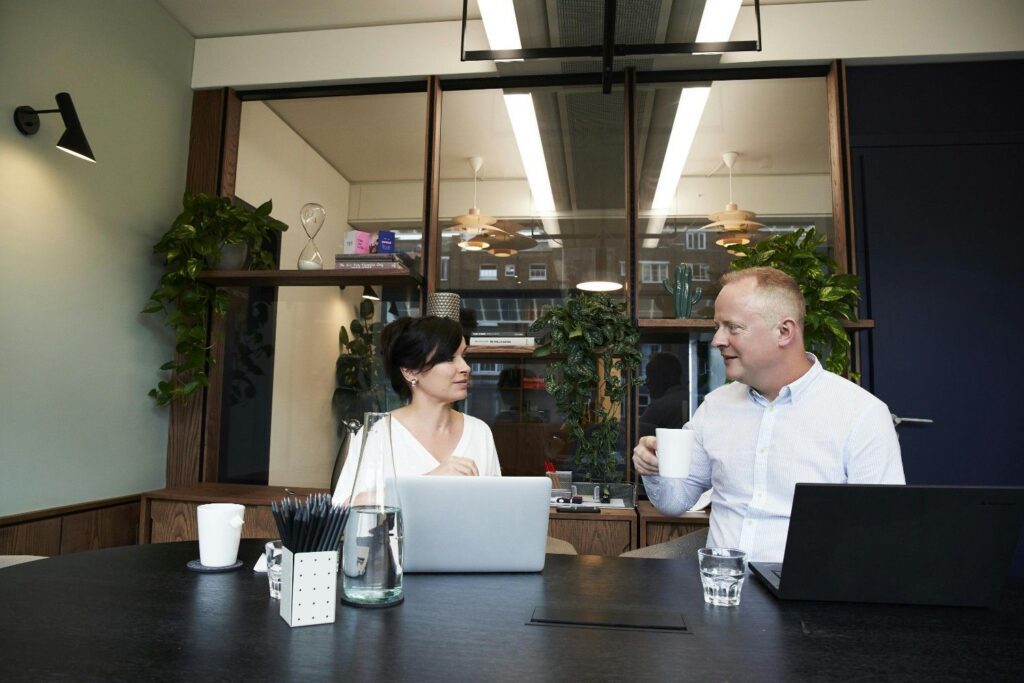Navigating Job Interviews: How to Excellently Answer the Top 5 Questions
Navigating Job Interviews: How to Excellently Answer the Top 5 Questions
Job interviews, a crucial step in the job search process, can be daunting. Yet, the key to success lies in thorough preparation. Amidst a landscape of high resignation rates leading to numerous job openings in the U.S., candidates find themselves amidst abundant opportunities. Preparing effectively for a job interview by understanding the qualifications and qualities sought by employers, as outlined in the job description, plays a pivotal role in reducing interview anxiety and enhancing performance.
This article serves as a comprehensive guide offering invaluable job interview tips, including strategies for answering top interview questions. It covers everything from mastering interview questions and answers, adopting the right interview body language, to showcasing a positive attitude. Furthermore, it emphasizes the importance of aligning oneself with position requirements, dressing appropriately according to the interview dress code, and strategically planning interview follow-up actions, including sending interview thank you notes. Whether you’re preparing for a phone interview or a video interview, this guide has you covered with specific tips to boost your interview skills and techniques.

Interview Question 1: Tell Us About Yourself
When responding to the classic interview prompt, “Tell me about yourself,” it’s crucial to craft a concise yet compelling narrative that aligns your background with the job you’re applying for. This question offers a prime opportunity to distinguish yourself from other candidates by presenting a clear picture of your professional journey and how it positions you uniquely for the role, effectively allowing you to describe your background in a manner that resonates with the interviewer.
Present, Past, Future Formula
- Start with the Present: Briefly describe your current position and responsibilities. Highlight a recent achievement to immediately capture the interviewer’s interest.
- Transition to the Past: Provide a snapshot of your previous experiences that are relevant to the job. This could include past jobs, key projects, and the skills you’ve developed.
- End with the Future: Explain why you are excited about the opportunity and how it aligns with your career goals. This shows your motivation and commitment to the role, reflecting a well-thought-out career planning strategy.
Structuring Your Response
- Professional Focus: Keep the conversation centered on your professional experiences and achievements.
- Relevance to the Job: Tailor your story to reflect the skills and experiences that directly relate to the job description.
- Brevity is Key: Aim to keep your response within two minutes. This helps maintain the interviewer’s attention and leaves room for further questions.
Practical Tips for a Strong Answer
- Practice Your Pitch: Rehearse your answer but ensure it sounds natural, not memorized.
- Use Empathy: Consider what the interviewer is looking for in a candidate and tailor your answer to meet those needs.
- Highlight Your Unique Qualities: Mention what sets you apart from other candidates, such as specific skills or experiences.
- Maintain Professionalism: While it’s great to show personality, keep the focus on your professional attributes.
By structuring your response to “Tell me about yourself” with these guidelines, you can effectively convey your suitability for the position while making a memorable first impression.

Interview Question 2: Why Do You Want To Work Here?
When faced with the interview question, “Why do you want to work here?” it’s essential to steer clear of generic responses and instead offer a well-researched and specific answer. This question is designed to gauge your genuine interest in the role and the company, ensuring you’re invested in the opportunity for the long haul.
Research and Preparation
- Research the Company:Understand the company’s mission, values, and culture. Familiarize yourself with its products, services, and industry standing.
- Identify Unique Attributes:Pinpoint what makes the company stand out in its sector—be it innovative products, a commitment to sustainability, or a distinctive work culture.
- Prepare Specific Points:Gather specific aspects of the company that resonate with your career goals and personal values.
Structuring Your Response
- Express Alignment with Company Values:Show how your personal values and professional aspirations align with the company’s mission and culture.
- Highlight Company Benefits: Discuss the company’s environment, growth opportunities, or social responsibility initiatives that appeal to you.
- Discuss Mutual Benefit:Explain how your skills and experiences will not only fit within the company but also contribute to its objectives and success.
Examples of Strong Responses
- “Given my background in environmental science, I am drawn to your commitment to sustainability and innovation in renewable energy. I see a great opportunity to contribute to your ongoing projects and help expand initiatives that align with global sustainability goals.”
- “I admire the collaborative culture your company promotes. Having thrived in team-oriented environments in the past, I am excited about the prospect of working in a place that values teamwork and open communication to achieve common goals.”
What to Avoid in Your Response
- Avoid mentioning benefits that are solely advantageous to you, like salary expectations, perks, or convenience of location.
- Steer clear of implying that the job is just a stepping stone for other opportunities or merely a necessity, avoiding the notion it’s part of a gap year strategy.
By constructing your answer with a focus on what you appreciate about the company and how you can contribute to its success, you demonstrate both your knowledge of the company and your eagerness to be a part of it. This approach shows that you are not only informed but also genuinely interested in being part of the company’s future.

Interview Question 3: What Is Your Greatest Strength?
Answering the interview question, “What is your greatest strength?” requires a blend of self-awareness, realism, and relevance to the job at hand. This question is not just about listing your skills, but also demonstrating how these strengths are applicable and beneficial to the position you are applying for.
Structured Approach to Answering
To effectively communicate your strengths, follow this structured approach:
- State Your Strength:Clearly identify a strength that is relevant to the position. Choose a strength that aligns with the job requirements and company values.
- Provide an Example:Share a specific instance where you successfully utilized this strength in a professional setting. This helps to contextualize your claim.
- Describe the Impact:Elaborate on the outcome of applying your strength and the positive impact it had on your previous job or project.
Context and Specificity
It is crucial to provide background and context when discussing your strength. Explain the circumstances under which you demonstrated the strength and the reasoning behind your decisions at that time. This not only shows your ability to think critically but also your capacity to make informed decisions.
Humility in Presentation
While it is important to confidently state your strengths, it is equally important to maintain humility. Avoid coming across as boastful; instead, focus on being factual and sincere about your capabilities and their relevance to the job.
Tailoring Examples by Job Type
- Analytical Jobs:Mention strengths like critical thinking or problem-solving. For instance, describe a time when your analytical ability helped streamline a complex process, leading to cost savings for your team. This experience also provided an excellent opportunity to improve your knowledge and further hone your problem-solving skills.
- Creative Jobs:If applying for a creative role, highlight strengths such as originality or flexibility. Share how your unique approach to a project brought fresh ideas that were well-received.
- Management Jobs:For leadership positions, focus on strengths like communication or teamwork. Discuss how these skills helped you lead a project to success or improve team dynamics.
- Hands-On Jobs:In roles that demand direct action, showcasing your ability to work independently, deal with pressure, and balance multiple projects is crucial. Provide examples of situations where your resilience and efficiency shone through, demonstrating how your hard work and dedication led to significant achievements under tight deadlines.
- Communication Jobs:For roles centered around engagement, possessing strengths like charisma or persuasive communication is essential. Illustrate how these strengths have enabled you to successfully negotiate deals or manage client relationships.
Preparation Tips
Prepare for this question by reflecting on your past experiences and selecting examples that best showcase your strengths. Practice articulating your answer to ensure clarity and confidence during the interview.
By following these guidelines, you can craft an answer that not only highlights your strengths but also demonstrates your suitability for the role, making a compelling case for why you are the ideal candidate.

Interview Question 4: Describe a Challenge and How You Overcame It
When tackling the interview question, “Describe a challenge and how you overcame it,” it’s essential to demonstrate your problem-solving skills, resilience, and adaptability, especially in stressful situations. This question provides a platform to showcase how you handle difficulties and grow from experiences, which are qualities highly valued in any role.
Using the STAR Method
The STAR method (Situation, Task, Actions, Result) is an effective framework for structuring your answer to interview questions, especially when discussing how you’ve navigated stressful situations or applied the star interview method.
- Situation:Describe the context within which you faced a challenge. Be specific about the details to set the stage.
- Task: Explain the task you needed to accomplish despite the challenges.
- Actions:Detail the steps you took to overcome the challenge. Focus on your initiative and the skills you utilized.
- Result:Share the outcome of your actions. Highlight any positive results or lessons learned that contributed to your professional development.
Selecting the Right Example
Choose a challenge that is relevant to the role you are applying for, aligning your example with the job description. This could be a professional scenario where you stepped in for a sick colleague on a critical project or developed a new time management system to meet tight deadlines.
Examples of Challenges and Solutions
Here are some scenarios you might consider discussing, depending on the nature of the job and your personal experiences:
- Stepping in for a Colleague:Describe how you took over an urgent project, coordinated with the team, and managed to meet the project deadlines effectively.
- Handling a Disgruntled Customer:Talk about a time when you faced a difficult customer, and how you used your communication skills to understand their issues and resolve their complaints satisfactorily.
- Improving Processes:Share an instance where you identified a bottleneck in a process and initiated changes that significantly improved efficiency.
Key Points to Emphasize
- Relevance:Always tie the challenge back to the job role you are applying for, showing how your ability to overcome obstacles makes you a suitable candidate.
- Soft Skills: Highlight skills like teamwork, communication, adaptability, and problem-solving throughout your narrative.
- Positive Framing:Even if the challenge was significant, focus on the positive aspects and what you learned from the experience.
Preparation Tips
- Reflect on Past Experiences:Think about various challenges you’ve faced in professional settings and choose one that best demonstrates your problem-solving capabilities.
- Practice Your Response: Rehearse your answer to ensure it’s concise, clear, and reflects your strengths.
- Be Honest:Authenticity goes a long way in interviews. Ensure that your story is true and reflects your actual contribution to solving the problem.
By carefully structuring your response and choosing the right example, you can effectively convey your ability to handle challenges, making a strong impression on potential employers.

Interview Question 5: Where Do You See Yourself in 5 Years?
When interviewers ask, “Where do you see yourself in 5 years?” they are looking to gauge whether your career goals and aspirations align with the company’s path and the role you’re applying for. It’s an opportunity to demonstrate your ambition, foresight, and alignment with the company’s objectives, showcasing your commitment to career planning.
Understanding the Purpose of the Question
Employers pose this question not just to peek into your career future, but to ascertain how your growth could align with the company’s trajectory. They seek to understand:
- Your long-term career vision and how the role fits into that plan.
- Your awareness of your professional identity and aspirations.
- Your potential longevity with the company, reducing turnover.
Crafting a Compelling Response
To construct an effective answer, follow these structured steps:
- Identify Your Career Goals:Reflect on where you realistically see your career heading in the next five years. Consider how these aspirations fit with the role you are applying for.
- Connect Goals with the Role:Explicitly tie your professional goals to the responsibilities and opportunities the position offers. For example, if you aspire to lead a team, mention how this role is a step towards that direction because of the leadership training or team management experiences it provides.
- Highlight Skills Development:Discuss the skills you aim to develop and how they are crucial for the role you want to grow into. Whether it’s technical skills, leadership abilities, or industry-specific knowledge, make it clear how these will be honed during your tenure with the company.
- Mention Contributions to the Company:Talk about the value you plan to add to the company. This could involve enhancing certain processes, contributing to projects, or bringing in new business opportunities.
- Keep It Broad Yet Relevant:While it’s good to have specific goals, ensure your answer allows for flexibility. Companies evolve, and showing that you are adaptable is as important as having clear objectives.
Examples of Effective Responses
- “In five years, I see myself as a seasoned project manager with deep expertise in managing large-scale tech deployments. I am excited about the opportunity to start as a project coordinator and grow into managing my own projects, contributing to the innovative solutions your company is known for.”
- “I aim to advance my skills in graphic design significantly, particularly in UX and UI. Your company’s commitment to cutting-edge online experiences is a perfect environment for these skills to flourish, and I see myself leading design projects that enhance user satisfaction.”
What to Avoid
- Avoid Overcommitment:Do not claim you see yourself in a specific role, such as the interviewer’s job, as this can come off as presumptuous.
- Steer Clear of Non-Professional Goals: Focus on professional aspirations rather than personal.
- Don’t Be Vague:While it’s good to be flexible, avoid answers like “I’m not sure,” which can signal a lack of direction.
By thoughtfully preparing for this question, you not only show that you are a forward-thinking candidate but also that you are a potential long-term asset to the company.

Conclusion
Navigating job interviews with confidence and strategic preparation can significantly enhance your chances of success in securing your desired role. This article has illuminated the path to answering five common but critical job interview questions, providing insights and strategies that align with the expectations of employers across various industries. From crafting a compelling personal narrative to expressing your long-term career aspirations in alignment with the company’s goals, the guidance offered here aims to equip you with the tools necessary to make a memorable impression on your potential employers.
The journey through job interviews is not just about showcasing your skills and experiences but also demonstrating your adaptability, problem-solving capabilities, and alignment with the company’s values and culture. As you move forward, let the strategies and examples shared in this article serve as a blueprint for your preparation. Reflecting on your unique qualities, practicing your responses, and maintaining a genuine enthusiasm for the opportunity will set the stage for a successful interview process. Remember, each interview is a step towards not only finding a new role but also advancing in your career trajectory.
FAQs
1. What are the key components of an effective interview?
The five key components, often referred to as the 5 C’s of interviewing, include Competency, Character, Communication Skills, Culture Fit, and Career Direction. Competency involves having the necessary technical skills to perform the tasks required by the job. It’s common for interviewers to conduct technical assessments to evaluate this.
2. How does the STAR method help in responding to interview questions?
The STAR method is a technique used to answer behavioral interview questions effectively. It involves outlining a Situation, describing the Task required, explaining the Action you took, and discussing the Result of that action. This method helps in providing clear and structured answers.
3. What is the best strategy for answering questions during an interview?
Preparing effectively is key to answering interview questions well. This preparation can include gathering information about the company, assessing your own skills and weaknesses, understanding key competencies required for the role, learning to think quickly under pressure, and practicing your responses to potential questions. Whether it’s your first interview or the next interview in your career, being well-prepared with thoughtful interview answers can significantly impact your success.
4. What are the five stages of a perfect interview?
A perfect interview typically progresses through five stages:
- Conducting introductions, where you meet and greet the hiring manager.
- Making conversation, which helps in building rapport.
- Gathering information, where more details about the job and candidate are exchanged.
- Performing the actual interview, where the core questions are asked.
- Concluding, which involves wrapping up the interview and discussing next steps.


